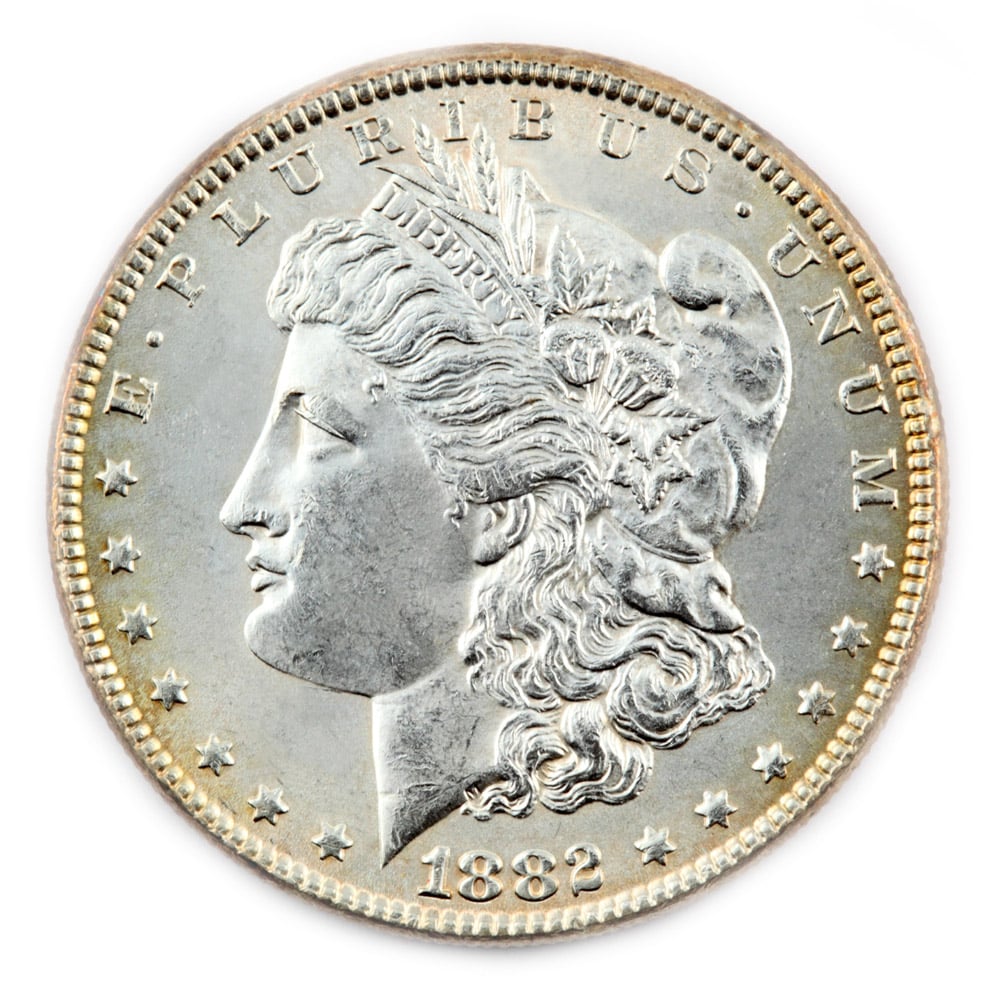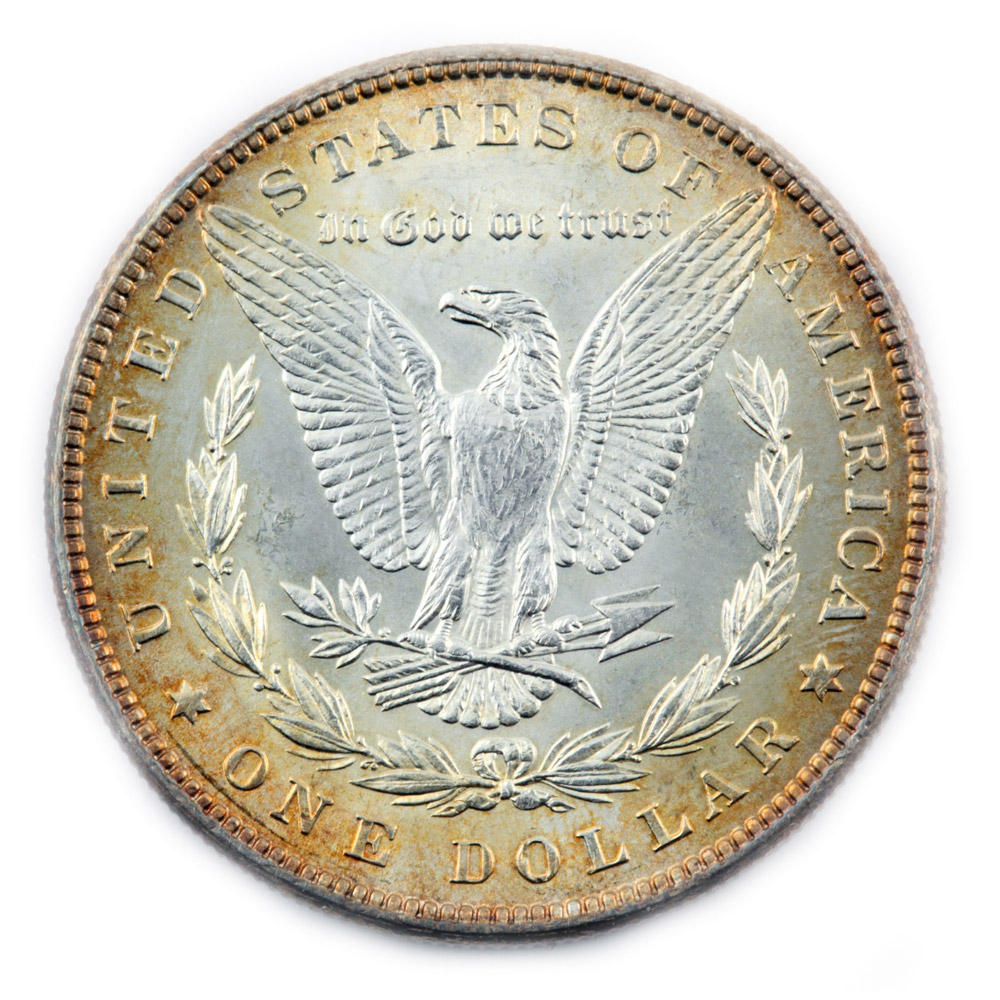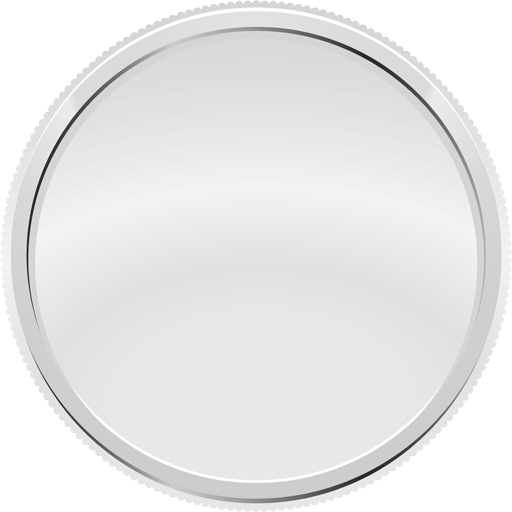About Numiis / Numis DB
The numismatic database project is designed to provide all information any coin collector or numismatist would need regarding a coin, medal or note of interest.
The morgan dollar value ranges from $1 to $100,000 depending on the quality of the coin, which year it was minted in, which mint it was manufactured at, and its strike type.


The Morgan Silver Dollar came about as a direct result of political pressure put on Congress by the silver-mining industry after the previous silver dollar - the Liberty Seated dollar - had been retired through legislation in 1873. The silver-mining lobby efforts resulted in the Bland-Allison Act, passed on February 28th, 1878, which required the Treasury to purchase between two to four million troy ounces of silver bullion each month to be minted into dollar coins. Coin design began in November 1877, in anticipation of the legislation, and Mint Director Henry P. Linderman ordered a contest between Chief Engraver William Barber and George T. Morgan, a British engraver working as an assistant to Linderman. Morgan's design won the competition, and the production of the Morgan Silver Dollar began on March 11th, 1878.
Despite Linderman's initial desire to use the San Francisco and Carson City mints to boost production to meet the high quotas established by the Bland-Allison Act, the initial short lifespan of the dies delayed their use as the western mints lacked the needed equipment to prepare the dies. After the Philadelphia mint was forced to halt production of all other coins and work overtime to meet quota requirements, the dies were sent to the western mints - arriving in both San Francisco and Carson City in 1878. Between all three mints, approximately 22,494,000 Morgan Silver Dollars were produced in 1878.
More than half a billion Morgan Silver Dollars were minted between 1878-1904. Nearly half of these coins - over 270,000,000 - were melted down as a result of the Pittman Act of 1918. Millions of silver coins, including the Morgan Silver Dollar, were melted as a result of the Wartime Silver Act of 1942, while millions more were likely melted down in 1979-1980 when the price of silver soared to over $50/ounce. It is unclear how many Morgan Silver Dollars - possibly as few as 1.4 million. Though this makes it a fairly common coin by numismatic standards, staggeringly few coins remain today compared to the total number struck.
ID: 55
 1878 8TF $1 MS
Mint Strike
1878 8TF $1 MS
Mint Strike
 1878 7/8TF STRONG $1 MS
Mint Strike
1878 7/8TF STRONG $1 MS
Mint Strike
 1878 7/8TF WEAK $1 MS
Mint Strike
1878 7/8TF WEAK $1 MS
Mint Strike
 1878 7TF REV OF 78 $1 MS
Mint Strike
1878 7TF REV OF 78 $1 MS
Mint Strike
 1878 7TF REV OF 79 $1 MS
Mint Strike
1878 7TF REV OF 79 $1 MS
Mint Strike
 1878 7TF REV OF 78 $1 PF
Proof
1878 7TF REV OF 78 $1 PF
Proof
 1878 8TF $1 PF
Proof
1878 8TF $1 PF
Proof
 1878 7TF REV OF 79 $1 PF
Proof
1878 7TF REV OF 79 $1 PF
Proof
 1878 S $1 SP
Special
1878 S $1 SP
Special
 1878 8TF TOP-100 VAM-9 FIRST D
1878 8TF TOP-100 VAM-9 FIRST D
 1878 S $1 MS
Mint Strike
1878 S $1 MS
Mint Strike
 1878 CC $1 MS
Mint Strike
1878 CC $1 MS
Mint Strike
 1879 $1 PF
Proof
1879 $1 PF
Proof
 1879 $1 MS
Mint Strike
1879 $1 MS
Mint Strike
 1879 S REV OF 78 TOP-100 $1 MS
Mint Strike
1879 S REV OF 78 TOP-100 $1 MS
Mint Strike
 1879 S $1 MS
Mint Strike
1879 S $1 MS
Mint Strike
 1879 O $1 MS
Mint Strike
1879 O $1 MS
Mint Strike
 1879 O $1 PF
Proof
1879 O $1 PF
Proof
 1879 CC $1 MS
Mint Strike
1879 CC $1 MS
Mint Strike
 1880 $1 MS
Mint Strike
1880 $1 MS
Mint Strike
 1880 $1 PF
Proof
1880 $1 PF
Proof
 1880 S $1 MS
Mint Strike
1880 S $1 MS
Mint Strike
 1880 O $1 MS
Mint Strike
1880 O $1 MS
Mint Strike
 1880 CC HITLIST-40 VAM-7 REV O
Mint Strike
1880 CC HITLIST-40 VAM-7 REV O
Mint Strike
 1880 CC $1 MS
Mint Strike
1880 CC $1 MS
Mint Strike
 1881 $1 MS
Mint Strike
1881 $1 MS
Mint Strike
 1881 $1 PF
Proof
1881 $1 PF
Proof
 1881 S $1 MS
Mint Strike
1881 S $1 MS
Mint Strike
 1881 O $1 MS
Mint Strike
1881 O $1 MS
Mint Strike
 1881 CC $1 MS
Mint Strike
1881 CC $1 MS
Mint Strike
 1882 $1 MS
Mint Strike
1882 $1 MS
Mint Strike
 1882 $1 PF
Proof
1882 $1 PF
Proof
 1882 S $1 MS
Mint Strike
1882 S $1 MS
Mint Strike
 1882 O/S $1 MS
Mint Strike
1882 O/S $1 MS
Mint Strike
 1882 O $1 MS
Mint Strike
1882 O $1 MS
Mint Strike
 1882 CC $1 MS
Mint Strike
1882 CC $1 MS
Mint Strike
 1882 CC $1 SP
Special
1882 CC $1 SP
Special
 1883 $1 MS
Mint Strike
1883 $1 MS
Mint Strike
 1883 $1 PF
Proof
1883 $1 PF
Proof
 1883 S $1 MS
Mint Strike
1883 S $1 MS
Mint Strike
 1883 O $1 MS
Mint Strike
1883 O $1 MS
Mint Strike
 1883 O $1 PF
Proof
1883 O $1 PF
Proof
 1883 O $1 SP
Special
1883 O $1 SP
Special
 1883 CC $1 MS
Mint Strike
1883 CC $1 MS
Mint Strike
 1883 CC $1 PF
Proof
1883 CC $1 PF
Proof
 1884 $1 PF
Proof
1884 $1 PF
Proof
 1884 S $1 MS
Mint Strike
1884 S $1 MS
Mint Strike
 1884 $1 MS
Mint Strike
1884 $1 MS
Mint Strike
 1884 O $1 MS
Mint Strike
1884 O $1 MS
Mint Strike
 1884 O $1 SP
Special
1884 O $1 SP
Special
 1884 CC $1 MS
Mint Strike
1884 CC $1 MS
Mint Strike
 1884 CC $1 PF
Proof
1884 CC $1 PF
Proof
 1884 CC $1 SP
Special
1884 CC $1 SP
Special
 1885 $1 MS
Mint Strike
1885 $1 MS
Mint Strike
 1885 $1 PF
Proof
1885 $1 PF
Proof
 1885 S $1 MS
Mint Strike
1885 S $1 MS
Mint Strike
 1885 O $1 MS
Mint Strike
1885 O $1 MS
Mint Strike
 1885 CC $1 MS
Mint Strike
1885 CC $1 MS
Mint Strike
 1885 CC $1 PF
Proof
1885 CC $1 PF
Proof
 1886 O $1 MS
Mint Strike
1886 O $1 MS
Mint Strike
 1886 $1 MS
Mint Strike
1886 $1 MS
Mint Strike
 1886 $1 PF
Proof
1886 $1 PF
Proof
 1886 S $1 MS
Mint Strike
1886 S $1 MS
Mint Strike
 1887 $1 MS
Mint Strike
1887 $1 MS
Mint Strike
 1887 $1 Ms
Mint Strike
1887 $1 Ms
Mint Strike
 1887 $1 PF
Proof
1887 $1 PF
Proof
 1887 O $1 SP
Special
1887 O $1 SP
Special
 1887 S $1 Ms
Mint Strike
1887 S $1 Ms
Mint Strike
 1887/6 O Top-100 Vam-3 $1 Ms
Mint Strike
1887/6 O Top-100 Vam-3 $1 Ms
Mint Strike
 1887 O $1 Ms
Mint Strike
1887 O $1 Ms
Mint Strike
 1887/6 Top-100 Vam-2 $1 Ms
Mint Strike
1887/6 Top-100 Vam-2 $1 Ms
Mint Strike
 1888 $1 Ms
Mint Strike
1888 $1 Ms
Mint Strike
 1888 $1 PF
Proof
1888 $1 PF
Proof
 1888 S $1 Ms
Mint Strike
1888 S $1 Ms
Mint Strike
 1888 O $1 Ms
Mint Strike
1888 O $1 Ms
Mint Strike
 1889 $1 Ms
Mint Strike
1889 $1 Ms
Mint Strike
 1889 $1 PF
Proof
1889 $1 PF
Proof
 1889 S $1 Ms
Mint Strike
1889 S $1 Ms
Mint Strike
 1889 O $1 Ms
Mint Strike
1889 O $1 Ms
Mint Strike
 1889 Cc $1 Ms
Mint Strike
1889 Cc $1 Ms
Mint Strike
 1890 $1 Ms
Mint Strike
1890 $1 Ms
Mint Strike
 1890 $1 PF
Proof
1890 $1 PF
Proof
 1890 S $1 Ms
Mint Strike
1890 S $1 Ms
Mint Strike
 1890 O $1 Ms
Mint Strike
1890 O $1 Ms
Mint Strike
 1890 Cc $1 Ms
Mint Strike
1890 Cc $1 Ms
Mint Strike
 1891 $1 Ms
Mint Strike
1891 $1 Ms
Mint Strike
 1891 $1 PF
Proof
1891 $1 PF
Proof
 1891 S $1 Ms
Mint Strike
1891 S $1 Ms
Mint Strike
 1891 O $1 Ms
Mint Strike
1891 O $1 Ms
Mint Strike
 1891 Cc $1 Ms
Mint Strike
1891 Cc $1 Ms
Mint Strike
 1892 $1 Ms
Mint Strike
1892 $1 Ms
Mint Strike
 1892 $1 PF
Proof
1892 $1 PF
Proof
 1892 S $1 Ms
Mint Strike
1892 S $1 Ms
Mint Strike
 1892 O $1 Ms
Mint Strike
1892 O $1 Ms
Mint Strike
 1892 Cc $1 Ms
Mint Strike
1892 Cc $1 Ms
Mint Strike
 1893 $1 Ms
Mint Strike
1893 $1 Ms
Mint Strike
 1893 $1 PF
Proof
1893 $1 PF
Proof
 1893 S $1 Ms
Mint Strike
1893 S $1 Ms
Mint Strike
 1893 O $1 Ms
Mint Strike
1893 O $1 Ms
Mint Strike
 1893 Cc $1 Ms
Mint Strike
1893 Cc $1 Ms
Mint Strike
 1893 CC $1 PF
Proof
1893 CC $1 PF
Proof
 1894 $1 Ms
Mint Strike
1894 $1 Ms
Mint Strike
 1894 S $1 Ms
Mint Strike
1894 S $1 Ms
Mint Strike
 1894 O $1 Ms
Mint Strike
1894 O $1 Ms
Mint Strike
 1894 $1 PF
Proof
1894 $1 PF
Proof
 1895 $1 PF
Proof
1895 $1 PF
Proof
 1895 S $1 Ms
Mint Strike
1895 S $1 Ms
Mint Strike
 1895 O $1 Ms
Mint Strike
1895 O $1 Ms
Mint Strike
 1895 O $1 PF
Proof
1895 O $1 PF
Proof
 1895 O $1 SP
Special
1895 O $1 SP
Special
 1896 $1 Ms
Mint Strike
1896 $1 Ms
Mint Strike
 1896 $1 PF
Proof
1896 $1 PF
Proof
 1896 S $1 Ms
Mint Strike
1896 S $1 Ms
Mint Strike
 1896 O $1 Ms
Mint Strike
1896 O $1 Ms
Mint Strike
 1896 O $1 SP
Special
1896 O $1 SP
Special
 1897 $1 Ms
Mint Strike
1897 $1 Ms
Mint Strike
 1897 $1 PF
Proof
1897 $1 PF
Proof
 1897 S $1 Ms
Mint Strike
1897 S $1 Ms
Mint Strike
 1897 O $1 Ms
Mint Strike
1897 O $1 Ms
Mint Strike
 1898 $1 Ms
Mint Strike
1898 $1 Ms
Mint Strike
 1898 $1 PF
Proof
1898 $1 PF
Proof
 1898 S $1 Ms
Mint Strike
1898 S $1 Ms
Mint Strike
 1898 O $1 Ms
Mint Strike
1898 O $1 Ms
Mint Strike
 1899 $1 Ms
Mint Strike
1899 $1 Ms
Mint Strike
 1899 $1 PF
Proof
1899 $1 PF
Proof
 1899 S $1 Ms
Mint Strike
1899 S $1 Ms
Mint Strike
 1899 O $1 Ms
Mint Strike
1899 O $1 Ms
Mint Strike
 1900 $1 Ms
Mint Strike
1900 $1 Ms
Mint Strike
 1900 $1 PF
Proof
1900 $1 PF
Proof
 1900 S $1 Ms
Mint Strike
1900 S $1 Ms
Mint Strike
 1900 O/Cc Top-100 $1 Ms
Mint Strike
1900 O/Cc Top-100 $1 Ms
Mint Strike
 1900 O $1 Ms
Mint Strike
1900 O $1 Ms
Mint Strike
 1901 $1 Ms
Mint Strike
1901 $1 Ms
Mint Strike
 1901 $1 PF
Proof
1901 $1 PF
Proof
 1901 S $1 Ms
Mint Strike
1901 S $1 Ms
Mint Strike
 1901 O $1 Ms
Mint Strike
1901 O $1 Ms
Mint Strike
 1902 $1 Ms
Mint Strike
1902 $1 Ms
Mint Strike
 1902 S $1 Ms
Mint Strike
1902 S $1 Ms
Mint Strike
 1902 $1 Ms
Mint Strike
1902 $1 Ms
Mint Strike
 1902 S $1 Ms
Mint Strike
1902 S $1 Ms
Mint Strike
 1902 $1 PF
Proof
1902 $1 PF
Proof
 1902 O $1 Ms
Mint Strike
1902 O $1 Ms
Mint Strike
 1902 O $1 Ms
Mint Strike
1902 O $1 Ms
Mint Strike
 1903 $1 Ms
Mint Strike
1903 $1 Ms
Mint Strike
 1903 $1 Ms
Mint Strike
1903 $1 Ms
Mint Strike
 1903 $1 PF
Proof
1903 $1 PF
Proof
 1903 S $1 Ms
Mint Strike
1903 S $1 Ms
Mint Strike
 1903 S $1 Ms
Mint Strike
1903 S $1 Ms
Mint Strike
 1903 O $1 Ms
Mint Strike
1903 O $1 Ms
Mint Strike
 1903 O $1 Ms
Mint Strike
1903 O $1 Ms
Mint Strike
 1904 $1 Ms
Mint Strike
1904 $1 Ms
Mint Strike
 1904 $1 Ms
Mint Strike
1904 $1 Ms
Mint Strike
 1904 $1 PF
Proof
1904 $1 PF
Proof
 1904 S $1 Ms
Mint Strike
1904 S $1 Ms
Mint Strike
 1904 S $1 Ms
Mint Strike
1904 S $1 Ms
Mint Strike
 1904 O $1 Ms
Mint Strike
1904 O $1 Ms
Mint Strike
 1904 O $1 Ms
Mint Strike
1904 O $1 Ms
Mint Strike
 1921 Morgan $1 Ms
Mint Strike
1921 Morgan $1 Ms
Mint Strike
 1921 Morgan $1 Ms
Mint Strike
1921 Morgan $1 Ms
Mint Strike
 1921 MORGAN ZERBE $1 PF
Proof
1921 MORGAN ZERBE $1 PF
Proof
 1921 MORGAN CHAPMAN $1 PF
Proof
1921 MORGAN CHAPMAN $1 PF
Proof
 1921 S $1 Ms
Mint Strike
1921 S $1 Ms
Mint Strike
 1921 S $1 Ms
Mint Strike
1921 S $1 Ms
Mint Strike
 1921 D $1 Ms
Mint Strike
1921 D $1 Ms
Mint Strike
 1921 D $1 Ms
Mint Strike
1921 D $1 Ms
Mint Strike
Sign up for exclusive access to the latest price trends, intelligence, auctions and more!
Gold $1,865.28 |
Silver $25.56 |
Platinum $998.24 |
Palladium $2,326.45
(Updated 2020-12-22)